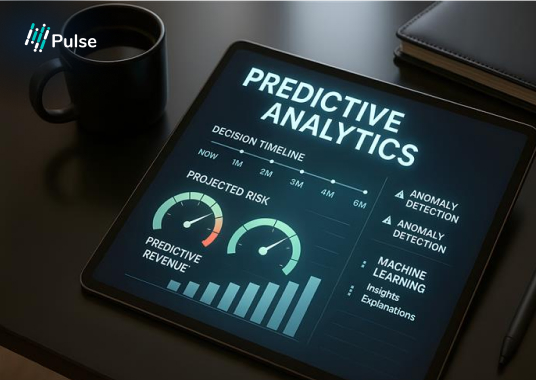In 2025, the world of predictive analytics in financial intelligence platforms (FIPs) is expected to undergo a significant transformation. Predictive models are now more powerful and complex than ever, thanks to the rapid growth of artificial intelligence and the emergence of new data sources.
Financial institutions today harness predictive analytics to not only foresee risks but also forecast disruptions, changes in regulations, and emerging fraud techniques.
As this technology develops, a few vital trends are changing how predictive analytics is utilised, controlled, and understood in financial intelligence platforms. Professionals who want to use predictive insights in a smart and responsible way need to understand these trends.
The Growth of Predictive Models using Generative AI
One of the biggest shifts would be in the use of generative AI techniques in predictive analytics. Rather than analysing historical data as is the case with traditional approaches, generative AI models will simulate a wide range of possible scenarios to help predict future outcomes. This allows financial intelligence platforms to handle uncertainty and rare events or scenarios.
For example, generative adversarial networks (GANs) and diffusion models create synthetic financial data that augment sparse datasets or simulate extreme market conditions, making models more reliable. This is an important ability because regulators and risk managers want stress testing that includes unexpected ‘black swan’ events, which were previously difficult for traditional predictive analytics to predict.
Being able to create and analyse countless plausible future scenarios helps institutions prepare for volatility or unplanned scenarios such as liquidity issues, market fluctuations or seasonal business changes.
Real-Time, Streaming Data Integration Becomes the Norm
The paradigm has shifted from batch analytics to analysing data in real-time and streaming it. Numerous financial intelligence tools imbibe and analyse live transactional data, social media sentiment, news feeds, and even changes in the world as they happen. This real-time connectivity enables predictive models to adapt on the fly, providing timely and relevant insights.
For example, fraud detection systems can now isolate irregular activity in seconds after it happens. This speed is achieved by integrating transaction patterns with real-time external signals, including rapid changes in travel restrictions or new information. This immediately lowers the risk of loss and strengthens compliance.
Hybrid Workflows Will Use Both Humans And AI Together
Even though automation has evolved, hybrid workflows will still remain crucial, where predictive analytics helps but doesn’t replace human expertise. Several financial intelligence platforms are incorporating explainable AI (XAI) features that provide explanations for the “why” behind forecasts. This lets analysts and compliance officers check and place model outputs in context.
This change meets legal requirements for transparency and addresses scepticism about “black boxes.” For instance, teams fighting money laundering can review cases that have been highlighted with precise model rationale, which makes the process more accurate and easier to verify.
Firms also pay for cross-disciplinary training programs so that their employees can speak both AI and finance fluently. This makes sure that decisions are made with a lot of thought. Predictive analytics stops being a lone oracle and starts being a tool for working together.
Fairness and Ethical AI Frameworks: From Buzzwords to Business Imperatives
In 2025, ethical AI will no longer be optional; it will be required since both regulators and customers are paying more attention to it. Fairness audits, bias detection algorithms, and privacy-preserving methods like federated learning are built into financial intelligence platforms as basic parts.
New global regulations require that institutions provide evidence to show that their predictions are accurate and fair for all demographic groups. These institutions must also declare how that data is utilised. Failing to comply with these requirements may lead to fines, damage to their brand, and loss of credibility.
Today, predictive analytics companies offer built-in governance dashboards that show fairness indicators, data lineage, and compliance status in real time. This makes ethical AI a real-world goal instead of just a theory.
The Rise of Alternative and Unstructured Data Sources
In 2025, the predictive power of financial intelligence platforms will depend a lot on adding data streams that go beyond standard financial measures. Alternative data sources, such as satellite images that trace supply chains, IoT sensor data from factories, and sentiment analysis from multilingual social media, provide us with a better picture of how the market is doing and how people are behaving.
With the use of breakthroughs in natural language processing (NLP), unstructured data analytics can now read regulatory filings, news stories, and even legal documents to find triggers that alter predictive models.
This diversification of data makes it easier to identify problems early on, but it also complicates the process of validating, integrating, and storing the data. Financial companies are utilising AI-powered data engineering solutions to integrate these disparate inputs without compromising data quality.
Automated Model Governance and Ongoing Monitoring
In 2025, model risk management will become easier due to the advancements in automation and AI. Financial intelligence platforms use continuous monitoring frameworks to keep an eye on model drift, performance drop, and unexpected correlations in real time.
Automated warnings are triggered when predictive models detect changes in the underlying data patterns, such as a rapid shift in the rules or a significant economic shock. This initiates an immediate investigation and retraining process. This flexibility reduces the likelihood of making incorrect or outdated predictions.
Also, regulations now require that model updates be documented and have audit trails. AI capabilities built into software automatically create compliance reports and version control logs, making monitoring easier and lessening the workload.
SaaS companies like Pulse are making waves with intuitive solutions that incorporate API integration, AI, machine learning and real-time data analytics. SMEs, accountants, banks and lenders can leverage these solutions to automate accounts receivable, make accurate cash flow forecasts, and harness advanced predictive analytics. From managing financial health to leveraging automation and reports, Pulse can help streamline, automate and optimise processes, setting the stage for exponential growth. To learn about how Pulse can help grow your business, book a demo today.
Conclusion: Finding Your Way in the Future of Predictive Analytics
The growth of predictive analytics in financial intelligence platforms in 2025 reveals both significant opportunities and more complex challenges. Scenario modelling, real-time streaming data, hybrid human-AI decision-making, and ethical governance frameworks are all part of generative AI. Together, they are ushering in a new era of predicted accuracy and accountability. To be successful, you need to leverage and carefully combine new technology while preserving the role of human judgment and moral standards for AI or predictive models.

















